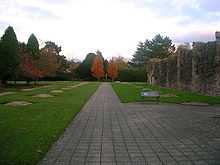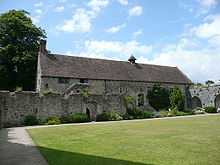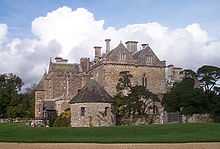Beaulieu Abbey
 The cloister and refectory of Beaulieu Abbey seen from the west range | |
| Monastery information | |
|---|---|
| Full name | The Abbey Church of St Mary, Bellus Locus Regis (Latin: "The beautiful place of the king") |
| Other names | Beaulieu Abbey |
| Order | Cistercian |
| Established | 1203/1204 |
| Disestablished | 1538 |
| Mother house | CîteauxAbbey, France |
| Dedicated to | Virgin Mary |
| Diocese | Winchester |
| Controlled churches | Shilton, Inglesham, Coxwell, St Keverne, |
| People | |
| Founder(s) | King John |
| Important associated figures | King John, Thomas Wriothesley, 1st Earl of Southampton, Abbot Thomas Stevens |
| Site | |
| Location | Beaulieu, Hampshire, England |
| Visible remains | cloister, refectory (now the parish church) and west range, gatehouse, foundations of the church, many other ruins, earthworks |
| Public access | yes |






Beaulieu Abbey, grid reference SU389026, was a Cistercian abbey located in Hampshire, England. It was founded in 1203-1204 by King John [1] and (uniquely in Britain) [2] peopled by 30 monks sent from the abbey of Cîteaux in France, the mother house of the Cistercian order. The Latin name of the monastery was Bellus Locus Regis ('The beautiful place of the king').
History of the Abbey
The first Abbot of Beaulieu was Hugh,[1] a man who stood high in the king's favour and who often served him on important diplomatic missions. He was later to become Bishop of Carlisle.[1] The king granted his new abbey a rich endowment, including numerous manors spread across southern England (particularly in Berkshire), land in the New Forest, corn, large amounts of money, building materials, 120 cows, 12 bulls, a golden chalice, and an annual tun of wine.[1] John's son and successor, King Henry III was equally generous to Beaulieu, with the result that the abbey became very wealthy,[1] though it was far from the richest English Cistercian house.
The abbey's buildings were of a scale and magnificence reflecting its status as an important royal foundation.[2] The church was a vast cruciform structure in early gothic style and heavily influenced by French churches of the order, especially those of Cîteaux, Bonport and Clairvaux.[3] The church was 102m long and had a semi-circular apse with 11 radiating chapels. The building took more than four decades to complete and was finally dedicated in 1246,[3] in the presence of King Henry III and his queen, Richard, Earl of Cornwall, and many prelates and nobles.
South of the church stood a cloister, ranged around which were the chapter house, refectory, kitchens, storehouse and quarters for the monks, lay brothers and the abbot. A separate infirmary complex lay to the east of the main buildings, connected to them by a passage.[4] The abbey was surrounded by workshops, farm buildings, guesthouses, a mill, and extensive gardens and fishponds. Strongly fortified gatehouses controlled entry to the monastic enclosure, which was defended by a wall. A water gate allowed access to ships in the river.[3]
Pope Innocent III constituted Beaulieu an "exempt abbey", meaning that the abbot had to answer to no bishop save the Pope himself.[1] Beaulieu was also invested by the same Pope with special privileges of sanctuary,[1] much stronger than usual and covering not only the abbey itself but all the 23.5ha precinct around that had been originally granted by King John. As Beaulieu was the only abbey in its region with such large and strongly enforced sanctuary rights it soon became a recourse of fugitives, both ordinary criminals and debtors and also political enemies of the government.[1] Among these latter were Anne Neville,[1] wife of Warwick the King-maker, after the battle of Barnet (1471). Twenty-six years later Perkin Warbeck fled to Beaulieu from the pursuing armies of Henry VII.[1]
Monks from Beaulieu founded four daughter houses, Netley Abbey (1239), Hailes Abbey (1246), Newenham Abbey (1247) and St Mary Graces Abbey (1350).
This place was the location for Most Haunted Live!'s Halloween event in 2003.
Dissolution
In 1535 the abbey's income was assessed in the Valor Ecclesiasticus, Henry VIII's great survey of church finances, at £428 gross, £326 net,[1] which meant that it escaped being confiscated under the terms of the first Suppression Act, Henry's initial move in the Dissolution of the Monasteries.
The last abbot of Beaulieu was Abbot Thomas Stevens, elected in 1536. Stevens was the former abbot of the recently dissolved abbey of Netley, across Southampton Water.[1] Beaulieu managed to survive until April 1538, at which point it was finally forced to surrender to the government.[1] Many of the monks were granted pensions, the abbot receiving 100 marks per year.[1] Abbot Thomas ended his days as treasurer of Salisbury Cathedral.[5] He died in 1550.[5]
At the dissolution of the monastery in 1538, the Commissioners for the Dissolution reported to the government that thirty-two sanctuary-men, who were here for debt, felony, or murder, were living in houses in the monastic precincts with their wives and families.[1] When the abbey was dissolved there was some debate about what to do with them, however, in the end it was decided, after pleading by the former abbot and certain government officials, to allow the debtors to live in their houses on the abbey grounds permanently.[1] Pardons were given to some of the criminals too, including one Thomas Jeynes, a murderer.[1]
Mansion
After Beaulieu fell there was much competition amongst courtiers to gain ownership of the abbey and its valuable estates, but eventually Thomas Wriothesley, 1st Earl of Southampton, won the struggle and King Henry granted him the abbey itself and 3,441ha of the Beaulieu lands.[3]
As soon as he took over, Wriothesley set about building himself a house on the site. He demolished the church, as was common practice but, unusually, instead of converting the buildings around the cloister into a home he chose the great gatehouse as the core of his mansion[3] (compare Wriothesley's other converted monastery at Titchfield Abbey or the conversion of neighbouring Netley Abbey). This survives - much extended - as the modern country house at Beaulieu known as Palace House. Lord Southampton preserved the monks' refectory, which he gave to the people of Beaulieu village to be their parish church,[3] a function it still serves today. The west range of the abbey, known as the Domus was also saved. The rest of the abbey was allowed to fall into ruin.
The Abbey Today
Although a great deal was destroyed at the time of the Dissolution of the Monasteries, there is still much to see. The groundplan of the 102 metre long church can be seen on the lawns. The position of the altar is marked by a cross and flanking trees. The Domus, once the lay brothers' refectory and lodgings and, later, chambers for important guests once the lay brothers had vanished, now houses an exhibition of monastic life prior to Thomas Wriothesley's takeover. Visitors can view a series of modern embroidered wall hangings made by Belinda, Lady Montagu,[6] depicting scenes from mediaeval monastic life and the history of the abbey since 1204. The abbey refectory survives as the parish church and there are substantial ruins of the other buildings round the cloister. The abbey cloister is a place of tranquillity, planted with fragrant herbs. The Domus is now regularly used for events, dining and corporate hospitality.[6] Beaulieu remains in the hands of the descendants of Wriothesley, who still live there. Both the abbey and Palace House are open to the public. The grounds are home to the National Motor Museum.
Folklore
Like many former monastic sites, Beaulieu has its fair share of legends attached. Ghostly monks have been reported in the abbey ruins and in the parish church and Gregorian chant and ghostly footsteps are said to have been heard.[6] The smell of incense has been reported in rooms of Palace House once used as chapels in the Middle Ages.[6] According to legend, this manifestation signals tragedy for the people of the abbey or Beaulieu village. The abbey is also said to have a post-Reformation ghost, a grey lady who is seen in Palace House. She is said to be the shade of an 18th-century inhabitant of the house, Lady Isabella.[6]
Beaulieu in Culture
F.T. Prince's poem 'At Beaulieu', from his 1963 collection, The Doors of Stone, describes the double heart-coffin on display in the Abbey. Prince, who was Professor of English at the University of Southampton from 1957 to 1974, probably visited the site sometime in the late 1950s/early '60s.
John Betjeman's 'Youth and Age on Beaulieu River' is based on a visit he made to the New Forest.
Beaulieu Attraction
Today the Abbey is part of the visitor attraction known simply as "Beaulieu". Admission includes the following attractions:
- Beaulieu Abbey
- National Motor Museum
- Beaulieu Palace House
- James Bond Experience - an exhibition of vehicles from the films
- World of Top Gear
- Secret Army Exhibition - an exhibit about the Special Operations Executive training at Beaulieu during World War II
- Gardens
- A monorail
- Rides
See also
- Great Coxwell Barn
- Titchfield Abbey
- Baron Montagu of Beaulieu
- List of English abbeys, priories and friaries serving as parish churches
Notes
- ↑ 1.0 1.1 1.2 1.3 1.4 1.5 1.6 1.7 1.8 1.9 1.10 1.11 1.12 1.13 1.14 1.15 1.16 Page, William; H. Arthur Doubleday (1973). Houses of Cistercian monks: Abbey of Netley, A History of the County of Hampshire: Volume II. The Victoria County History. pp. 140–146. ISBN 0-7129-0592-8.
- ↑ 2.0 2.1 Robinson, David; Janet Burton, Nicola Coldstream, Glyn Coppack & Richard Fawcett (1998). The Cistercian Abbeys of Britain. Batsford Ltd. p. 68. ISBN 978-0-7134-8392-5.
- ↑ 3.0 3.1 3.2 3.3 3.4 3.5 Robinson, David; Janet Burton, Nicola Coldstream, Glyn Coppack & Richard Fawcett (1998). The Cistercian Abbeys of Britain. Batsford Ltd. p. 69. ISBN 978-0-7134-8392-5.
- ↑ Platt, Professor Colin (1984). The Abbeys and Priories of Medieval England. Secker & Warburg. p. 169. ISBN 0-436-37557-5.
- ↑ 5.0 5.1 Horn, Joyce (1973). Fasti Ecclesiae Anglicanae 1541-1857: Volume VI: Salisbury Diocese. The Victoria County History. pp. 12–13. ISBN 0-901179-91-4.
- ↑ 6.0 6.1 6.2 6.3 6.4 http://www.beaulieu.co.uk/beaulieuabbey/index.htm
External links
| Wikimedia Commons has media related to Beaulieu Abbey. |
- Beaulieu - official attraction site including the Abbey
- In-depth history of the abbey from the Victoria County History
- Beaulieu at The Heritage Trail
- Beaulieu on the Sheffield University Cistercian abbeys website
- Image of Palace House, the Tudor and later mansion built around the former monastic gatehouse. The mediaeval building is on the right
- Ruins of the chapter house of the abbey
Coordinates: 50°49′18″N 1°26′57″W / 50.82164°N 1.44913°W